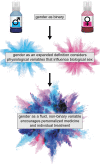Beyond Binary: Influence of Sex and Gender on Outcome after Traumatic Brain Injury
- PMID: 32808570
- PMCID: PMC7698832
- DOI: 10.1089/neu.2020.7230
Beyond Binary: Influence of Sex and Gender on Outcome after Traumatic Brain Injury
Abstract
Traumatic brain injury (TBI) affects millions of individuals each year and is a leading cause of death and disability worldwide. TBI is heterogeneous and outcome is influenced by a combination of factors that include injury location, severity, genetics, and environmental factors. More recently, sex as a biological variable has been incorporated into TBI research, although there is conflicting literature regarding clinical outcomes in males versus females after TBI. We review the current clinical literature investigating sex differences after TBI. We focus our discussion on differences within contemporary gender categories to suggest that binary categories of male and female are not sufficient to guide clinical decisions for neurotrauma. Some studies have considered physiological variables that influence sex such as hormone cycles and stages in males and females pre- and post-TBI. These data suggest that there are phasic differences within male populations and within female populations that influence an individual's outcome after TBI. Finally, we discuss the impact of gender identity and expression on outcome after TBI and highlight the lack of neurotrauma research that includes non-binary individuals. Social constructs regarding gender impact an individual's vulnerability to violence and consequent TBI, including the successful reintegration to society after TBI. We call for incorporation of gender beyond the binary in TBI education, research, and clinical care. Precision medicine necessarily must progress beyond the binary to treat individuals after TBI.
Keywords: gender; hormones; non-binary; sex; traumatic brain injury.
Conflict of interest statement
No competing financial interests exist.
Figures

References
-
- Peterson A.B., Xu L., Daugherty J., and Breiding M.J. (2019). Surveillance report of traumatic brain injury-related emergency department visits, hospitalizations, and deaths, United States, 2014. Centers for Disease Control and Prevention. https://www.cdc.gov/traumaticbraininjury/pdf/TBI-Surveillance-Report-FIN... (Last accessed July2, 2020)
-
- McCrory P., Meeuwisse W., Dvorak J., Aubry M., Bailes J., Broglio S., Cantu R.C., Cassidy D., Echemendia R.J., and Castellani R.J. (2017). Consensus statement on concussion in sport—the 5th International Conference on Concussion in Sport held in Berlin, October 2016. Br. J. Sports Med. 51, 838–847 - PubMed
-
- Faul M., and Coronado V. (2015). Epidemiology of traumatic brain injury. Handb. Clin. Neurol. 127, 3–13 - PubMed
-
- Blennow K., Brody D.L., Kochanek P.M., Levin H., McKee A., Ribbers G.M., Yaffe K., and Zetterberg H. (2016). Traumatic brain injuries. Nat. Rev. Dis. Primers 2, 16084. - PubMed
-
- Baird K.L. (1999). The new NIH and FDA medical research policies: targeting gender, promoting justice. J. Health Polit. Policy Law 24, 531–565 - PubMed
Publication types
MeSH terms
Grants and funding
LinkOut - more resources
Full Text Sources
Medical
Miscellaneous

